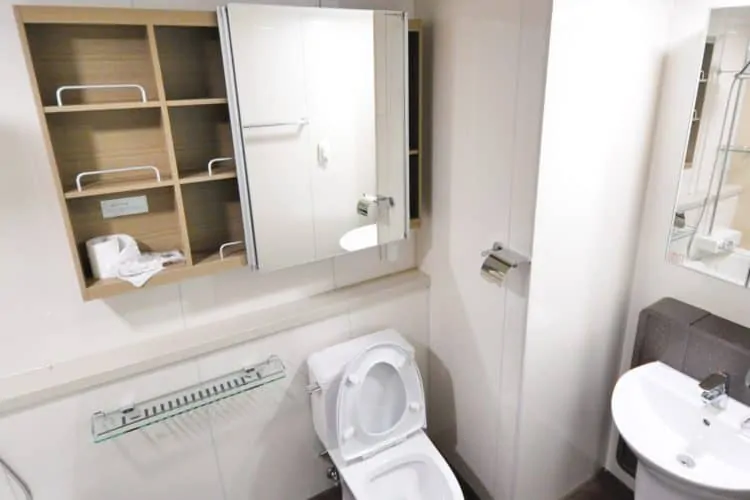
7 Functional Aging in Place Bathroom Solutions and Designs
When it comes to aging-in-place planning, one of the most important rooms to consider is the bathroom. It’s a room you use every day, and with the added factor of showering or bathing, it’s easy for it to become a dangerous place if not properly outfitted with an aging-in-place bathroom design. Here are some of our favorite aging-in-place bathroom and bath solutions for your home.
Grab Bars & Handrails
Although sometimes considered a harsh or hospital-like installation for aging in place shower design, grab bars and handles are truly useful. In addition, there have been many design strides made in the last several years that can assist you in installing a “grab bar” that is both functional and fashionable. Today, you can find grab bars in a variety of styles and colors to match your decor and taste.
Installing grab bars can dramatically and economically increase safety in the bathroom. (They also can be helpful in bedrooms, hallways or any other place where standing or walking assistance is needed.) If you are thinking about remodeling your bathroom anytime soon, you might want to go ahead and install bracing in walls around the tub, shower, shower seat, and toilet even if you do not plan on installing grab bars now. This will get the walls prepared to support the grab bars when you are ready and keep you from additional remodeling later.
When it comes time to install grab bars, at the toilet, grab bars can help with sitting and standing. In the tub or shower, they can help a person to stand (or stay standing) and safely get in and out of the shower. Consider several installed on the interior and exterior of the shower (or tub). For best results, grab bars should have some sort of texture to them for ease-of-grip.
A final tip: grab bars typically need to be able to support 250 to 300 pounds, so plan for that weight allowance.
Accessible Showers
The shower (or bath) is a crucial element of aging-in-place bathroom design. One of the top design options for making your shower age-friendly is replacing an existing tub or shower with a barrier-free shower.
Usually, the threshold is the primary issue – if it’s too high or there is a step of any sort, entry and exit into the shower become much more difficult with age. There are a few options for getting around this, such as installing a walk-in shower (where there is no threshold at all), leveling the threshold (an easier fix that installing a brand new shower), or an option that’s become more popular in recent years: a safeway step. A safeway step can be your best bet when a full shower remodel isn’t feasible, since it entails cutting out a section of your current bathtub for easier “walk-in” and a much more accessible and safe shower or bath environment.
Another often overlooked remodel element for aging-in-place shower and bath solutions is the showerhead itself. An adjustable shower head, which moves to suit the height and position most comfortable for a user, is a great way to add accessibility to a bathroom. Combining it with a hand-held shower head creates an even more functional experience. This is an easy upgrade to make at any stage of life that will benefit you and your family for years to come.
A truly unique option for aging-in-place bathroom redesigns are the walk-in baths. This type of design involves elevating the walls of your “tub” so can you walk right into the tub (the same as you would with a shower).
With many state of the art technological advances, you can even choose to install jets and other additions to your walk-in bathtub. Some walk-in bathtubs offer a variety of therapeutic benefits via hydrotherapy systems, which can actually help to increase mobility, relieve pain, boost energy and improve sleep.
Wet Room
Another option to be considered for aging in place shower design is a wet room. This is one of the simplest bathroom floor plans. A wet room is essentially a large shower that has a toilet and vanity in it; it will typically have one or two central drains and all areas of the room will be waterproofed. This design allows for a very open area that creates the ultimate accessible shower for any age. It also is one of the easiest to clean since you have fewer nooks and crannies to deal with.
A wet room is also a bathroom design that will allow for a lot of open space – an important factor for aging-in-place design. Keep in mind that space will be a greater issue as you age. “As you transition from mid-life to senior to elderly, planning for the use of canes, wheelchairs, walkers or similar assistive devices is a good idea. The ideal situation would be to have plenty of clear space to accommodate someone in a wheelchair around the toilet, bathtub or shower stalls and areas around cabinets and closets” (AgeinPlace.com).
Whether you opt for a wet room, a shower or tub, for overall bathing safety and usability, you may want to think about moving the tub and shower water controls closer to the entry-point so they can be reached from outside the bathing area. That way you won’t have to overextend and risk slipping or falling when reaching to turn on your tub or shower from the outside.
Another slipping-prevention design adjustment would be installing a shelf in the bath or shower area for soap, shampoo, and towels. So, when you finish bathing or showering, you can easily reach your towel and not have to stretch outside of the tub or shower and risk falling.
Accessible Sinks
In addition to the shower or bathtub, the vanity and sink should be considered for aging-in-place bathroom remodeling. You can either modify your existing vanity sink or install a custom-made vanity sink that is more accessible to older house-members.
An ideal solution is lowering sink heights to accommodate wheelchairs. This is not a drastic change, but adding it to your bathrooms earlier in life will only benefit aging residents down the road. To optimize for usability with wheelchair accessible sink, hang on a sturdy and reinforced wall, and be sure to provide space for your knees (or wheelchair) underneath a pipe-covering panel to protect user’s legs. Another great suggestion installing a dual-level sink – this style of sink is a nice choice for families with children of all ages and will prove helpful as an aging-in-place design adjustment as well.
And while you’re adjusting sink design, take another look at your cabinets too. Mirrored medicine cabinets may prove to be problematic for aging-in-place design. Other options, like open shelves, may prove easier to use, or you can install glass-front doors on your cabinets to easily see inside them without opening.
One of the easiest things to do to implement aging-in-place bathroom design is installing lever handle faucets. Lever handle faucets all people of almost all abilities to easily turn faucets on or off (much more so than twist or lift faucets). Lever handle faucets are also the most user-friendly for those with arthritis or hand-mobility issues.
Another faucet option for aging-in place design are pedal-controlled faucets. Pedal-operated faucets are actually one of the most efficient water control methods since they allow you to turn the water on and off using the foot levers in order to avoid waste. This type of faucet can help you save on home water usage, as well as modernize your house for aging-in-place.
A final consideration for aging-in-place sink design is for safety – consider making all water pressure-controlled and installing anti-scald controls to prevent burns.
Shower/Bath Seats
Another great bathroom design for aging-in-place is shower seats or benches. Shower seats can add comfort and safety to your bathing experience as you age with your home as shower seat can relieve the strain experienced with standing for extended periods of time. In general, shower seats improve safety and lessen the chance of falling, which is desirable for bathroom aging-in-place design.
There are many types of shower seats to choose from, such as shower stools, shower chairs, retractable or fold-down shower seats, or even a built-in bench that can be a more seamless design update. Sometimes bath seats can be installed to your existing shower set up, but more often than not, walls will need to be reinforced to support more weight. Shower seats are an increasingly common feature yet are often not utilized the way they were intended because most seats are placed too far from the showerhead and faucet levers.
To promote design efficiency from the very beginning, be sure to install your shower seat closer to these features, or opt for a moveable seat. Moveable seats can be a more flexible and less expensive option and can be much more easily maneuvered to fit needs as life progresses. Of course, if you opt for a moveable seat, you will need to make sure it can be easily and securely anchored when moved – otherwise, it will end up being more hazard than a help.
If you choose to install a shower seat of any kind, make sure to strategically position it near your shower handles or grab bars.
Helpful Lighting
An often overlooked design element to assess for aging-in-place bathroom remodeling is the lighting of your bathroom.
The bathroom itself will require improved lighting to promote aging-in-place design. To avoid potential with glare as you age, consider side or eye level lighting. For example, sconces on both sides of the mirror are easier on the eyes than overhead lights. You can also introduce light from a window or skylight to provide a natural source of light that you won’t have to worry about replacing (at least during the day).
In addition, you should definitely have a light in the shower stall if there is not one. The bathtub and shower stall are known to be one of the most accident-prone areas, especially for seniors and older homeowners, so additional lighting in the shower area is a wise choice.
Some other bathroom lighting considerations: install light switches by each entrance to halls and rooms, and make sure light receptacles in the bathroom have at least two light bulbs, so you always have a backup bulb if one goes out.
And don’t forget night-lights! Auto-sensor night lights are an absolute must-have for middle-of-the-night bathroom breaks, specifically on the pathway from the bedroom to the bathroom.
Floors
A final crucial consideration for aging in place bathroom remodeling are the floors. It goes without saying that your bathroom should be free of slippery floor surfaces, especially as you age into your 60s and 70s. Directly inside and outside of the shower/bathtub, you should install slip-resistant/anti-skid tile or vinyl. You can also up the safety factor by opting for textured tile over smooth tile. Smaller tiles embedded in grout also provide more friction to reduce slip rates.
When it comes to improving the safety of bathroom floors, many homeowners think that rugs help by covering up slick surfaces, but in fact, the opposite is true. Throw rugs are a major cause of tripping and falling in the home, especially with seniors. If you choose to keep rugs in your home as you implement aging-in-place design, purchase a rug with a low pile and secure it with anti-slip rug tape found at most major home improvement stores. But, it is a much smarter choice to remove rugs from your home as you approach this stage in life, and opt for safer options like permanent carpet or no-slip tile instead.
As you can see, adding aging-in-place design elements to your bathroom doesn’t need to be boring! There are many options to transition your current bathroom into a place you can use for years to come without having to sacrifice style. Use the tips above to create the bathroom of your dreams that you can grow old with.











